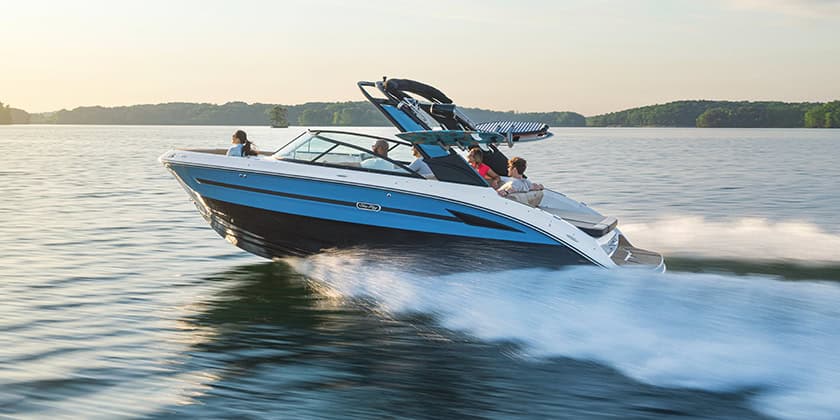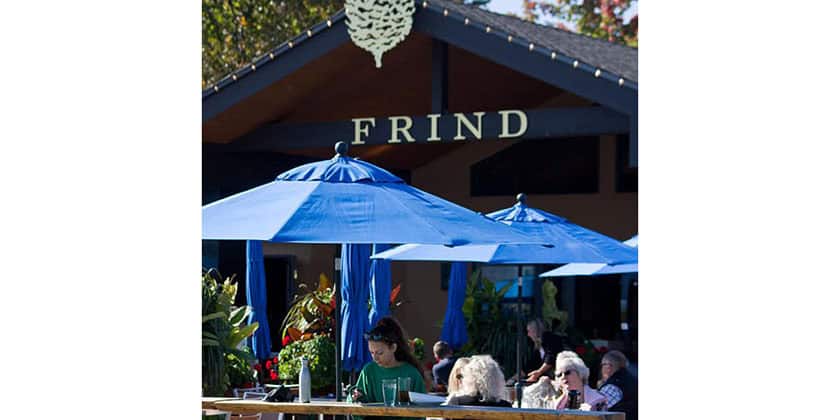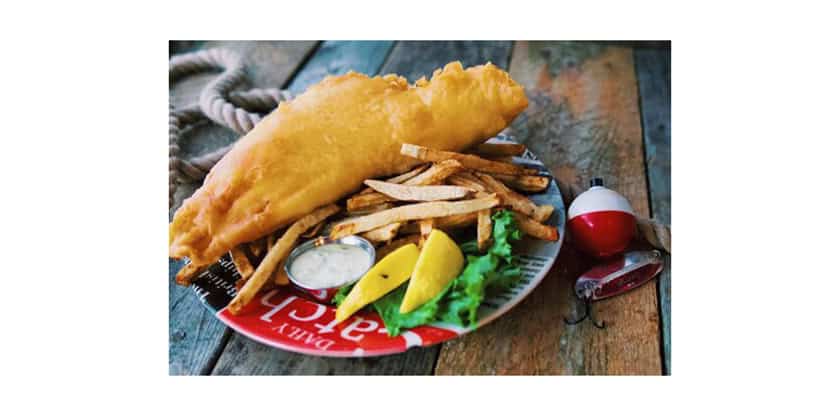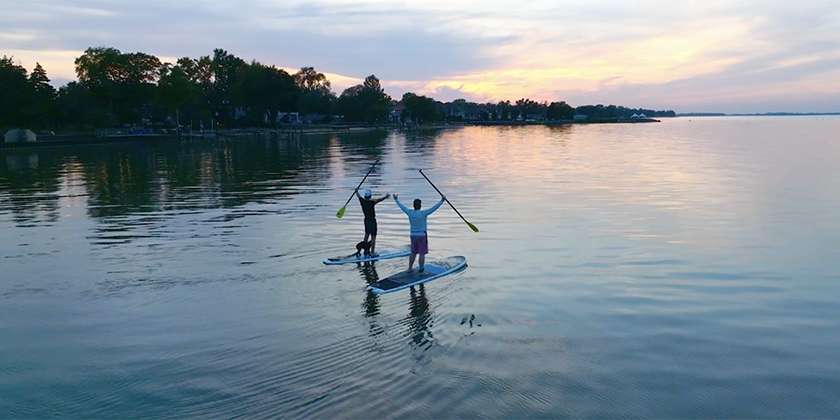Freestyle 474
John Turnbull
Motorcyclists and single-handed catamaran sailors have something in common: a love of speed. “Speed,” wrote Aldous Huxley, “provides the one genuinely modern pleasure.” The catamaran is the one genuinely modern sailing boat, and it’s built for speed.
Its development, despite centuries old roots in Polynesian ocean-going canoes, is all fairly recent. The other day I saw a comparison between a C-class cat of 1965 and the 1978 version. No other type of boat has undergone such extreme transformation, and some of the fundamental improvements are beginning to show up in smaller catamarans.
The choice among one-man cats has been limited to the off-the-beach Hobie 14, a spritely performer and widely raced, and the home-built and relatively rare A-class cats raced by a devoted breed of acrobat/woodcrafters.
A modern and practical alternative now on the market is the Californian designed and Canadian-built Freestyle 474. This trim, up-to-date, trapeze-equipped cat has the jump on and takeoff appeal that is bound to succeed, es-pecially with its far lower price than the U.S. built imports.
Late last fall I had the opportunity to test-sail the 474 along with expert Olympic (Tornado) sailor Larry Woods. I’m fairly new to catamaran sailing; like most well brought-up yachtsmen I simply was not encouraged to sail cats. So Larry and I were able to look at the boat from the expert’s and beginner’s points of view.
Larry took the 474 out first in a light swell with perhaps 18 knots of wind. To use the phrase a Nova Scotian friend of mine likes, “he sure did some movin’.” The speed of that tall, single rig sweeping the horizon really is astounding. What’s even more shocking is the sting of spray that shoots off the bows while you’re trying to see where you’re headed.
Two of us aboard the boat probably reduced performance, but there was plenty left over. Steering was a little hairy but the bows had less tendency to bury than with only Larry aboard. This tendency to lift their transoms and head for the bottom is shared by almost all really fast cats. It’s a consequence of high centre of effort (particularly with a single-sail rig) and the need to keep volume out of the bows for a narrow entry.
The 474 pitches like most cats but has two features that make it more exhilarating than scary. First, freeboard at the bows is higher than usual, which makes them harder to push under. Secondly, when they do go under, the water flowing right back to the forward crossbeam seems to meet only marginally more resistance. The decks are round and the hulls so narrow that Larry was able to push the leeward bow under several times and continue to sail at high speed. Any flatness on deck or flare in the forward section would have caught and tripped the boat forward. Cat sailors occasionally end up in front of their catamarans the same way motorcyclists end up overtaking their handlebars.
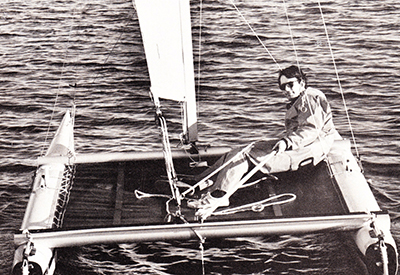 The stresses set up between the two hulls in this kind of sailing, even in a fairly small cat like the 474, demand some careful engineering. After a couple of modifications to the California prototype builder Bill Snyders is confident that strength is adequate. This has been done without adding significantly to the boat’s weight or subtracting from it’s trim appearance.
The stresses set up between the two hulls in this kind of sailing, even in a fairly small cat like the 474, demand some careful engineering. After a couple of modifications to the California prototype builder Bill Snyders is confident that strength is adequate. This has been done without adding significantly to the boat’s weight or subtracting from it’s trim appearance.
By the time I was able to get the 474 all to myself, there was much less wind. Sailing her was somewhat less sensa-tional but still lots of fun. In any over-canvassed and underweight boat, the difference between in-the-groove sail trim and “out to lunch” is a subtle thing. The challenge of keeping a whispy breeze driving over the full height of the fully-battened sail is an exercise in concentration and control.
This fine boat-speed control is the essence of catamaran sailing in any wind and explains why cats can go shooting past each other for no easily discernible reason.
The 474 rig is not an easy one to control. It is simple in that it has no boom and no control for mast rotation, which has a lot of appeal for people new to sailing who don’t want to be bothered with the “extra” hardware, but this ab-sence of boom and mast lever make control of twist through leech tension fairly difficult. The twist of this tall, nar-row sail is very important since cat sails are always travelling through a quickly changing apparent wind and a small range of angles. Reducing twist is accomplished by leech tension which means being able to pull down on the clew without sacrificing shape in the bottom sections.
A full-width traveller across the rear crossbeam makes this control possible in theory but a little tricky in practice. This kind of trickiness has made other class boats a challenge to race, while the beginning sailor really won’t care about optimum trim. One helpful innovation is in the mainsheet and traveller control being one continuous line so that you will never find yourself hiked out to windward while the traveller control is hanging over the leeward side.
The rudders and daggerboards are small by comparison with other cats with similar sail areas. This is because a lat-eral plane will develop lift exponentially with increasing speed. The faster you go the less lateral surface you need and the faster you go. “Speed begets speed.” At low speed, however, these tiny rudders demand attention and pa-tience. For anyone used to flipping a dinghy around with a flick of the tiller, bringing a cat around can be frustrating the first couple of times. Though it’s not very hard to get the boat over onto the other tack, you lose everything in the process and have to start up from zero knots on the new tack and prod the boat back up to top speed.
Monohull sailors will also have to get used to passing the enormous hiking stick around behind the mainsheet on each tack. The hiking stick is long, of course, because the helmsman is often out on the trapeze well forward. Any-one who does much serious trapezing on the 474 will want to install foot-loops or put a non-skid surface on the gunwales. I didn’t have enough wind to use the wire on the 474, but I can tell you the view from six feet beyond the weather hull of a single-handed cat is enough to make you forget your own name.
The quality of workmanship on the 474 meets a fairly high standard. It isn’t fussy but it is thorough. Bill Snyders has been able to improve on the bond between the upper and lower moldings so that the seam is smooth and sound. Metal parts are “Anolock” anodized which, according to Alcan, gives them a thicker coating.
Fittings (there aren’t very many of them) are racing-quality and the trampoline is tough and well-constructed.
The current price of the Freestyle 474 is $2,895 (1979). If they can hold the price, Freestyle Canada Ltd. will have a winner.
Originally published in Canadian Yachting’s March 1979 issue.
Specifications:
Length: 15 ft 6 in
Beam: 8 ft
Sail Area: 156 sq ft
Weight: 260 lbs
Mast Height: 27 ft
Photo Captions:
Photo 1 – Boom-less rig is difficult to trim.
Photo 2 – State of the art hull shape and good quality fittings.










